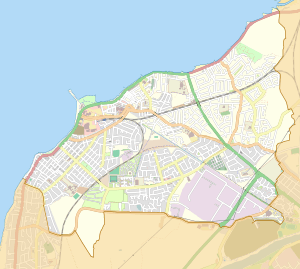Midland Hotel, Morecambe
| Midland Hotel | |
|---|---|
 | |
 Location within Morecambe | |
| General information | |
| Type | Hotel |
| Architectural style | Streamline Moderne |
| Town or city | Morecambe, Lancashire |
| Country | England |
| Coordinates | 54°04′20″N 2°52′31″W / 54.0721°N 2.8754°WCoordinates: 54°04′20″N 2°52′31″W / 54.0721°N 2.8754°W |
| Opened | July 1933 |
| Technical details | |
| Material | Concrete and rendered brickwork |
| Floor count | 3 |
| Design and construction | |
| Architect | Oliver Hill |
| Renovating team | |
| Architect | Union North |
| Website | |
|
englishlakes | |
Listed Building – Grade II* | |
| Designated | 8 October 1976 |
| Reference no. | 1208988 |
The Midland Hotel is a Streamline Moderne building in Morecambe, Lancashire, England. It was built by the London, Midland and Scottish Railway (LMS), in 1933, to the designs of architect Oliver Hill, with sculpture by Eric Gill, and murals by Eric Ravilious (subsequently destroyed).[1][2] It is a Grade II* listed building. The hotel has been restored by Urban Splash with architects Union North, Northwest Regional Development Agency and Lancaster City Council.
Construction
.jpg)
The Midland Hotel was built to replace two earlier hotels: the North Western Hotel built in 1848 by the "little" North Western Railway which had been renamed the Midland Hotel in 1871 when the Midland Railway took over the North Western Railway; and another hotel at Heysham, the Heysham Towers, which was converted from a private house in 1896.[1][2] The Heysham Towers served railway steamer traffic from Heysham Harbour to Belfast; but it was not a success and was sold in 1919.[1]
In 1932, the London, Midland and Scottish Railway (LMS) bought land from Morecambe Corporation to build the 40-bedroom Midland Hotel replacing the old hotel. It opened in July 1933.[1]
The design
The hotel is designed in the Streamline Moderne style of Art Deco. Oliver Hill designed a three-storey curving building, with a central circular tower containing the entrance and a spiral staircase, and a circular cafe at the north end. The front of the hotel is decorated with two Art Deco seahorses, which can be viewed at close proximity from the hotel's rooftop terrace.
The hotel stands on the seafront with the concave side facing the sea, and the convex side facing the former Morecambe Promenade railway station – in homage to the railway company whose showcase hotel this was. Hill designed the hotel to complement the curve of the promenade, which allowed guests to view spectacular panoramas of the North West coast.
War time use and disposal
During the Second World War the Midland Hotel, along with most of the large hotels and garages in the town was requisitioned, either for the newly created RAF Station, RAF Morecambe or the Civil Service.
The hotel became the station's hospital, opening on 17 February 1940. The Senior Medical Officer was Wing Commander R.C.L. Fisher. The hotel was stripped of its valuable carpets and rugs and the Gill mural was covered. By June 1941 the station magazine, Morecambe Wings was reporting that the hospital had already treated 3700 patients, including 160 major operations and 400 minor ones.
Also reported was the average attendance at the massage clinic of 33 people daily, but this was declining due to the end of the football season. Up to June 1941, over 1,000 airmen had been fitted with spectacles and over 100,000 had been inoculated or vaccinated. The hospital was visited in February 1941 by Princess Mary, Princess Royal, accompanied by Air Vice-Marshal W. Tyrell. At the time the station commander was Group Captain E. Hillman-Gray.[3]
On nationalisation of the railways, ownership transferred to the British Transport Commission (BTC) on 1 January 1948 coming under the control of the BTC's Railway Executive; however on 1 July 1948, along with the other railway hotels, ownership was transferred to the BTC's Hotels Executive.[4] It was sold by the BTC in 1952.[1]
A new lease of life

Union North were employed as architects by Urban Splash for the refurbishment and expansion of the hotel commencing in 2006. It opened its doors to the public in the summer of 2008.
In April 2009 Urban Splash announced a partnership with English Lakes Hotels to manage the Midland Hotel from 8 April 2009.[5] Further developments on the Central Promenade were completed by Urban Splash.[6]
Other history
The hotel was used in filming episodes of the TV series Agatha Christie's Poirot, starring David Suchet, in 1989, most notably in the episode 'Double Sin' where Poirot has brought Captain Hastings to stimulate "the little grey cells."[7]
See also
- Grade II* listed buildings in Lancashire
- Listed buildings in Morecambe
- Eric Gill at the Midland Hotel, Morecambe
- British Transport Hotels
- Joldwynds (Oliver Hill, 1932)
References
- 1 2 3 4 5 Carter, Oliver (1990). An illustrated history of British Railway Hotels: 1838-1983. St Michael's: Silver Link Publishing. ISBN 0-947971-36-X
- 1 2 Simmons, Jack and Biddle, Gordon (1997). The Oxford Companion to British Railway History: From 1603 to the 1990s. Oxford: Oxford University Press. ISBN 0-19-211697-5.
- ↑ The Midland Hotel, Morecambe's White Hope
- ↑ Skelsey, Geoffrey (2006). "Famous Hotel-Keepers for over a century: British Railway Hotels under State Ownership, 1948-84". In: Back Track, Volume 20, No. 7 (July 2006). Pp 390 - 399. ISSN 0955-5382.
- ↑ English Lakes Hotels News Archive
- ↑ "Splash 'committed' to finishing Morecambe scheme". Place North West. 19 August 2010. Retrieved 6 September 2010.
- ↑ Article in The Visitor
External links
| Wikimedia Commons has media related to Midland Hotel, Morecambe. |
- English Lakes Hotels
- The Midland Hotel Website
- Friends of the Midland Hotel site
- Information on the original Architect - Oliver Hill
- The Midland Hotel at Morecambe, October 2001, The Twentieth Century Society